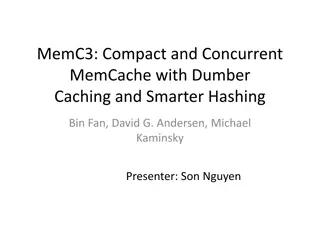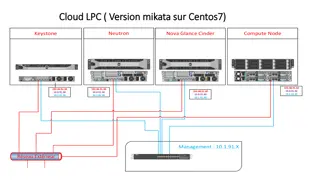
Scaling Memcache at Facebook
Explore the design goals and requirements of scaling Memcache at Facebook, addressing issues like congestion control, load reduction, and georedundancy. Learn about the terminology, challenges like Incast Congestion, and the role of memcached as a key-value store. Discover solutions for handling high read loads, implementing query caching, and supporting rapid feature deployment while ensuring system flexibility and scalability.
Download Presentation

Please find below an Image/Link to download the presentation.
The content on the website is provided AS IS for your information and personal use only. It may not be sold, licensed, or shared on other websites without obtaining consent from the author. If you encounter any issues during the download, it is possible that the publisher has removed the file from their server.
You are allowed to download the files provided on this website for personal or commercial use, subject to the condition that they are used lawfully. All files are the property of their respective owners.
The content on the website is provided AS IS for your information and personal use only. It may not be sold, licensed, or shared on other websites without obtaining consent from the author.
E N D
Presentation Transcript
Scaling Memcache at Facebook
Agenda Background memcache Design Goals memcache as a Query Cache Congestion Control Reducing Load Failure Recovery Georedundancy Single-Server Performance
Terminology memcached memcache Incast congestion
Incast Congestion Many simultaneous responses overwhelm a shared networking resource
memcached Basic building block for a distributed key-value store at Facebook Trillions of items Billions of requests / second Network-attached in-memory hash table Supports LRU based eviction set, get, delete, nothing else Single-threaded* Persistence not a goal
memcache Problem: too many requests Solution: caching! Read-heavy (2 orders of magnitude) more reads than writes ...but memcached is for a single server ...must be scaled Persistence not a goal
memcache Design Requirements Support a very heavy read load Over 1 billion reads / second Insulate backend services from high read rates Geographically distributed Support a constantly evolving product System must be flexible enough to support a variety of use cases Support rapid deployment of new features Persistence not a goal ...but support mechanisms to refill after updates
memcache as a Query Cache: Reads Two orders of magnitude more reads than writes Solution: deploy a few memcache hosts to handle the read capacity Demand-filled look-aside cache Common case is data is available in the cache Over UDP
memcache as a Query Cache: Reads High fanout and multiple rounds of data fetching
memcache as a Query Cache: Updates memcache needs to be invalidated after DB write Prefer deletes to sets Idempotent Demand-filled Up to web application to specify which keys to invalidate after database update Over TCP
memcache as a Query Cache: Invalidation Up to web application to specify which keys to invalidate after database update mcsqueal daemon deployed on every database Inspects the SQL statements that its database commits (tails commit log) Extracts deletes Broadcasts deletes to its associated memcache deployment Allows caches to be resynchronized in the event of a problem (just replay) Most (96%) of updates are not actually deletes Too much network traffic
memcache as a Query Cache: Invalidation Still a lot of packets Can reduce further by having mcsqueal batch deletes into fewer packets 18x improvement in the median number of deletes per packet
Congestion Control Reads use UDP, not TCP UDP has no congestion control ...but we do want congestion control ...just not the overhead of a TCP connection Solution: reimplement TCP-like sliding window over UDP
Reducing Load with Leases Solves stale sets and thundering herds problems with leases Stale sets: can happen when concurrent updates get reordered A sends foo=1 to memcache B sends foo=2 to memcache foo=2 arrives at memcache foo=1 arrives at memcache memcache thinks foo=1 Thundering herds: heavy read/write traffic, more requests hitting slow path
Reducing Load with Leases memcached instance gives a lease to a client on cache miss 64-bit token bound to the specific key originally requested Write may fail if the token has been invalidated by a delete for that key Only hand out one lease every 10 seconds (thundering herds) Notify concurrent readers to try again soon Writes are usually fast (few milliseconds)
Reducing Load with Leases: Analysis Seems to work well in practice On a set of keys particularly susceptible to thundering herds for on week : 17K/s peak database query rate without leases 1.3K/s with leases
Reducing Load by Returning Stale Values Some applications are fine with slightly stale values On delete, key-value is set aside for a short time in a separate structure Applications can obtain leases on this stale data Make forward progress without waiting on database Data evicted a short time later
Reducing Load by Pooling by Churn memcached has LRU policy memcache is not application-specific; serves many Mixing low-churn, expensive-to-reconstruct keys with high-churn, inexpensive keys is bad End up evicting the expensive keys before the inexpensive ones Main idea: split up items by churn characteristics Default wildcard pool Create pool for hot keys and cold keys
Reducing Load by Replicating memcached is largely network-bound Small difference between retrieving 1 keys per request and retrieving 100 One server holding 100 keys can respond to 500K reqs/s Each request asks for all 100 Splitting the server into two, 50/50 Each server still can only respond to 500K reqs/s Not actually faster Solution: replicate the entire server, if: Multi-key requests are common; Entire dataset can fit on a single server; and Request rate is too high for a single server ...must now deliver invalidations to all replicas
Handling Failures Two major scales: A small number of hosts are inaccessible due to a network or server failure A widespread outage affects a significant percentage of cluster servers Large outages require manual intervention Can still try to recover from small ones
Handling Failures Introduce idle Gutter machines in cluster (approx. 1%) Being idle is important to prevent cascading failures When memcached client times out on get request, assumes server failure Retries request on Gutter: If this also misses, client will hit DB for data and insert it into Gutter Lots of clients will time out and hit Gutter (better than DB) Hack: invalidation is hard, so instead have Gutter entries expire quickly Stale data, but at least system is up
Cold Cluster Warmup Problem: bringing up a cluster is slow, lots of DB reads Solution: read from an already-running ( warm ) cluster instead Possible race conditions, 4.3 Cold Cluster Warmup
Cross-Region Replication Necessary for data durability and availability One region holds master database, others hold replicas Synced via MyQL replication Plays well with mcsqueal Avoids race condition where invalidation arrives before data has been replicated
Cross-Region Replication Writes from a master region are easy to handle Don't need to do anything special mcsqueal will handle invalidation in each region
Cross-Region Replication Writes from non-master region are harder If replication lag is sufficient, user can make an update, refresh their page, and not see their changes Cache refill should only be allowed from replica database once it s caught up Remote marker mechanism: tag a key in local replica as being possibly- stale
Single-Server Performance Improvements Communication is all-to-all, so a single server can become a bottleneck Make memcached multi-threaded (upstreamed) Protected by one big global lock Experimented with finer-grained locks Allow internal hashtable to automatically expand (upstreamed) Give each thread its own UDP port to avoid contention (not upstreamed)
Miscellaneous memcache stores its values in System V shared memory Allows data to remain live across a software disruption Otherwise, rolling takes a long time ( over 12 hours to upgrade a set ) Adaptive slab allocator: periodically re-balance buckets based on usage Transient item cache: Short lived keys take a long time to get evicted from LRU Put them in a bucketed-by-second linked list
Lessons Learned (from NSDI presentation) Push complexity into the client whenever possible Operational efficiency is as important as performance Separating cache and persistent store allows them to be scaled independently



